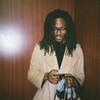Provincetown, Massachusetts, 2015. Photo courtesy of Sam Shahid
New York, New York, 1976. Photo courtesy of Sam Shahid
Sam Shahid: I've shown these photos to a lot of people, some of whom I don't know that well, and they all said, "God, this needs to be seen." There's a celebration, there's a pride. That's what's great about it; there's no shame. [In New York during these years,] you were able to express yourself any way you wanted to. I think there was just a celebration of ourselves, basically.
A Sunday afternoon with a friend in New York City, 1976. Says Shahid, "He found a bra in the dryer and called me over with my camera." Photos courtesy of Sam Shahid
New York City Pride Parade, 2015. Photo courtesy of Sam Shahid
I had some friends who looked at this and said, "We need this now." You know, let them see us. I think that's important, because even though we've come a long way in places like New York and LA, when you go outside of there, it's not like we'd like it to be.That's like with Trump. A lot of people [on the coasts], when they went out to do the polls, you would ask, "Who are you voting for?" and they would say Clinton in denial. They didn't want people to know that they were voting for Trump, but secretly they were. I think the same thing happens in regards to the gay community. In New York, yes, we're "accepted," but underneath it all there are a lot of people out there who I think don't accept us. They do so publicly because it's the thing to do right now, but underneath, I think there's still a disgust with the gay community. I can hear it sometimes when you're talking to someone, and they don't realize you're gay.
Visiting with friends in Fire Island Pines, 1978. Photo courtesy of Sam Shahid
When Anita Bryant came against the gays, that's really when you saw the big turning point in New York. The pride parades before that—you used to go to Central Park, and it was very small. It was getting a little bigger and a little bigger, but when Anita Bryant came against the gays, you really saw New Yorkers and the gay community show themselves in force. After that, it still even kept getting bigger and bigger. It was great, because all your life you feel like you're not accepted, and it's a completely different world you have to try to fit into. You feel like no one understood you and accepted you. This showed that that wasn't true. This was the first time the community really came together and said "enough."
Gay Pride March, New York City, 1977. Photo courtesy of Sam Shahid
Photographer Stewart Shining in Water Mill, New York, 2013. Photo courtesy of Sam Shahid
No. I say no because I think it's just part of me. I've been very lucky that I've been able to work with people like Bruce [Weber] and Herb [Ritts] and other photographers. We connected, and we had clients that connected. I think who I am is [in these issues] and it's [in my advertising work], but I don't think one influenced the other. It's all just one continuation.
An 80s themed Carnival in Provincetown, Massachusetts, 2016. Photo courtesy of Sam Shahid
New York City Pride Parade, 2005. Photo courtesy of Sam Shahid
Hopefully things are going to get better, especially when you think about same-sex marriage and the fact that kids are involved now. I think it'll all change once we have a gay president. I have known people who would tell me "no gay man or woman could ever hold a political office"—women and straight guys, they would make jokes of it. This was back in the 70s and 80s. Look what's happened.I remember when AIDS came about. It wasn't called AIDS at the time, but it seemed so distant from us. But then, I was at Calvin Klein, and I ran the in-house advertising, and you just didn't talk about it. If someone in your office—I had two guys in my office, that were friends of mine—had AIDS, you just didn't talk about it. I couldn't tell Calvin that. I made sure they had a car to get to the hospital and all of that and kept it quiet, but we did not talk about it. In those days, there was such a stigma, the idea that the fashion industry wouldn't buy our clothes.I remember how people would go to the funeral of their boyfriend or their lover and then go right back to work and not mention any of it. So we've come a long way. When I look at Anita Bryant and the things she said, no one could do that today. Yes, Mike Pence can be against same-sex marriage and that kind of thing, and yet we can demonstrate in front of his house and be safe doing that. Also, I think people really question when you say homophobic things now; it's like, "really?" But I believe when we have a gay president it's going to be divine. I hope I can live long enough to see that happen.
From a Candyland-themed Carnival in Provincetown, Massachusetts, 2015. Photo courtesy of Sam Shahid
